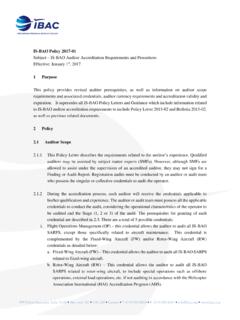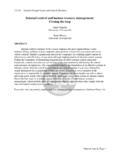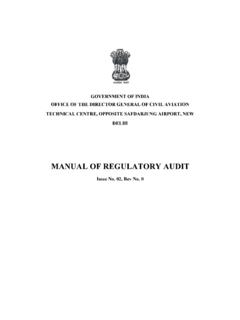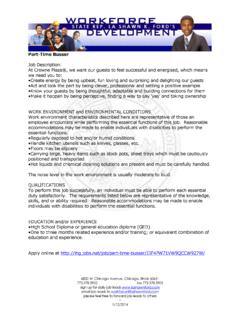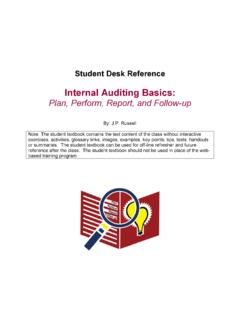Transcription of How to Build an Audit Risk Assessment Tool
1 REFERENCE GUIDEJ onathan EstreichDecember 2014 How to Build an Audit Risk Assessment tool to Combat Money Laundering and Terrorist Financing Introduction4 Key Points10 Developing the Risk Assessment Tool22 The Support Framework24 Interpreting and Using Results28 TakeawayREFERENCE GUIDE SECtIoNSThe author is not necessarily representing the views or opinions of JPMorgan Chase or ACAMS.
2 This document serves as a supplemental resource to the whitepaper published in December of 2013: How to Build an Audit Risk Assessment tool to Combat Money Laundering and Terrorist provide specific considerations for how a financial institution s internal Audit department can design a firm-wide AML risk Assessment tool that: Improves the auditor s ability to identify relevant AML risksSets the foundation for thoughtful and supported risk determinationsProduces results that can assist in the development of an Audit plan that satisfies regulatory expectationsHow to Build an Audit Risk Assessment tool to Combat Money Laundering and Terrorist Financing3 Introduction A strong and well-designed tool should equip the auditor to identify risk and to demonstrate and evidence how risk ratings and related conclusions were derived.
3 To Build an Audit Risk Assessment tool to Combat Money Laundering and Terrorist Financing51. Regulatory expectations are high and the auditor s role is evolvingRegulators are emphasizing the importance of independent testing and the role of the AML auditor in helping to manage risk and sustain an operational AML a review of the FI s risk Assessment for reasonableness given the FI s risk profile: Audit is responsible for conducting an objective evaluation of the AML compliance program for soundness, adequacy and sustainability while maintaining independence from compliance and business functions.
4 CustomersProducts and ServicesTransaction ActivityGeographic PresenceAdditional focus on:u Risk toleranceu The level of assuranceu The depth and precision of controlsu The nature of substantive testingu The degree of credible challengeRegulatory Orders (2012, 2013)u Inadequate CDD and EDD practicesu Incomplete identification of high-risk customersu Insufficient policies, procedures and trainingu Failures in monitoring and identifying suspicious activityu Poor suspicious activity reporting and filing practicesu Ineffective independent testing and Audit functionsKey Points1 Regulatory expectations are high and the auditor s role is evolving2 The Audit plan indicates to regulators whether Audit is on track3 Audit s risk Assessment process drives the Audit plan4 There is a difference between an Audit AMLRA and other AML risk assessments
5 To Build an Audit Risk Assessment tool to Combat Money Laundering and Terrorist Financing72. The Audit plan indicates to regulators whether Audit is on track Audit is responsible for assembling an Audit plan that demonstrates its organization s knowledge of its Business Units and an understanding of the business associated risks . An Audit plan that includes every possible auditable Business Unit is arguably not a plan and is most likely an unrealistic approach in a world of finite resources.
6 The Audit Plan:u Primary roadmap for AML testing activitiesu If the plan is lacking, the FI may be exposed u Should, at a minimum, focus on the highest-risk areasA successful risk Assessment should:u Result in a detailed risk profile for each Business Unitu Demonstrate the rationale and inform decisions for including or excluding a specific Audit area in the plankEy poINtS3. Audit s risk Assessment process drives the Audit plan Audit is expected to select audits using a risk-based approach that provides a reasonable belief that critical risks are identified and assigned adequate testing coverage in a timely fashion.
7 Risk ProfileAudit CoverageScopeFrequencyThe process of building the Audit plan should involve consideration of:Overview Of Primary Audit Objectivesu Determine whether the overall AML/BSA compliance program is suitably designed and operating effectively. u Identify any material program weaknesses, control deficiencies and corresponding opportunities for program, process and control enhancements, and report them to senior management and the board (usually the Audit committee).u Assist management with identifying money laundering, terrorism financing and other financial crime Perform and document procedures and results that may be useful to regulators in conducting their supervisory Assess and identify possible gaps and opportunities for management to continually improve its suspicious activity detection, investigation, analysis, escala-tion, documentation and reporting processes and controls, including due diligence feedback and the enterprise-wide AML risk assess-ment process.
8 U Assess management s AML strategic planning Identify opportunities and methods to help management make program enhancements continuous and Assess and identify opportunities to enhance management s self- monitoring and self-testing compli-ance review program. u Assess how well AML compliance is integrated into the business. Adapted from: The SAR Activity Review Trends, Tips and Issues (Issue 16), (October, 2009).Existing or Prior Audit CoverageUnique Business RisksPre-existing issuesSeverity of AML risk factorsHow to Build an Audit Risk Assessment tool to Combat Money Laundering and Terrorist Financing94.
9 There is a difference between an Audit AMLRA and other AMLRAs Differences between risk Assessment tools do exist, and these may be attributed to who the tool is designed for and how the results will ultimately be used. It is reasonable for Audit to reflect a combined approach of independently deriving some pieces of information while leveraging other pieces granted a reasonable level of comfort. kEy poINtSAUDIT AMLRAIDENTIFY AND ASSESS RISK WITH THE PURPOSE OF:1 Pinpointing areas warranting immediate escalation2 Pinpointing areas warranting further substantiation and testingUsually completed by an auditor or other Audit department designeeAn effective Audit AMLRA should assist with Audit decisions relating to.
10 U Whether the FI s risk Assessment processes are effectiveu What Business Units should be auditedu What AML components within a Business Unit may warrant testing coverageu The frequency for which a Business Unit may need to be testedu Prioritization and timing of Audit coverage across Business Unitsu Potential resourcing demands for conducting the resulting auditsHow to Build an Audit Risk Assessment tool to Combat Money Laundering and Terrorist Financing111. OverviewA strong AMLRA design leads, directs and guides the auditor s focus and helps the auditor to successfully assess risk while avoiding generalizations.
